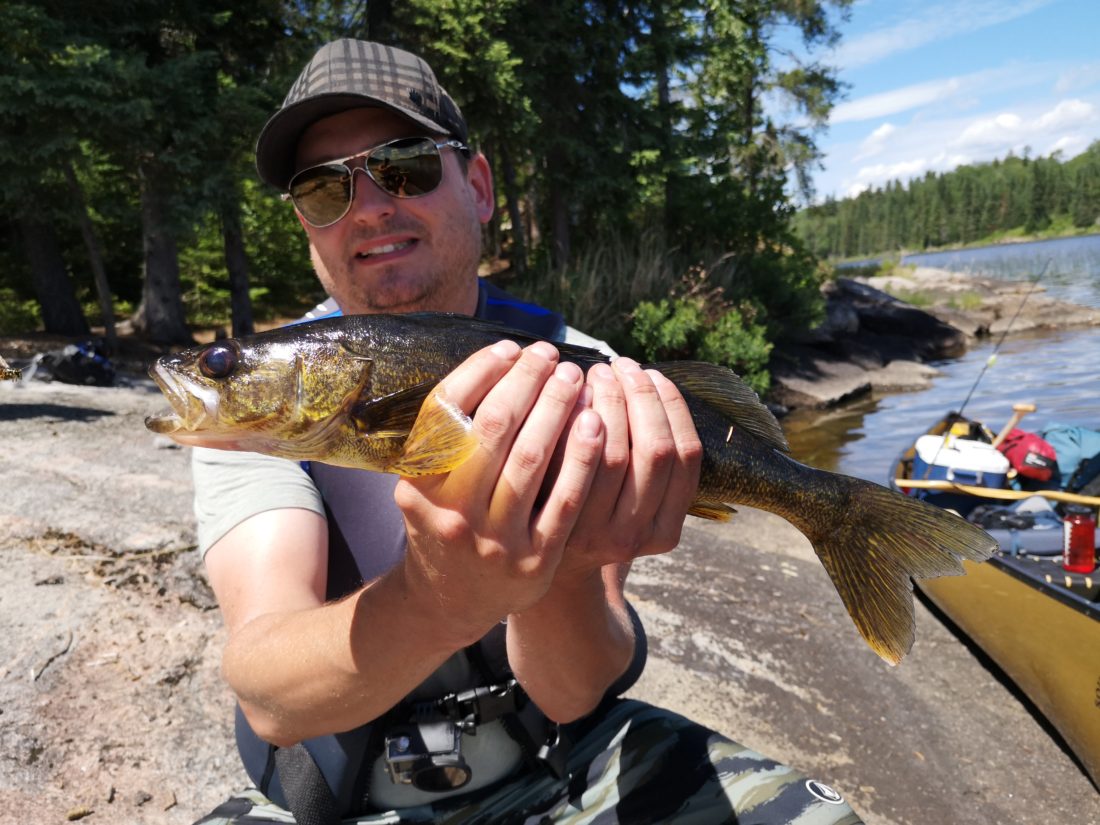Fishing for spring walleye is one of the great experiences of fishing. It is one of the few times of year that both shore and boat fishers can catch huge amounts of great tasting fish. Of course, like many other species, this is because of the spawn. Similar to pike, walleye spawn in shallow water and move out deeper as spring turns into summer. If you know where and when they can be found, you can reliably catch dinner. With a little luck and patience, you might even bring in a trophy.

Spring Walleye Spawn Timing
Like many fish, walleye spawn in the spring. However, spring can be quite different in different areas. Here in southern Manitoba that usually falls sometime in April or early May. Farther to the north, spring may not arrive until well into June. Regardless of the timing, the key factor that determines spawning is water temperature.
Ideal temperatures typically range from about 6° to 9° Celsius, which means that unlike pike, you will not typically see walleye spawn before ice-out. Interestingly, if those ideal water temperatures are not met early enough, for example in the far north, they will sometimes absorb their eggs and forego spawning.

That’s When, How About Where?
Walleye spawning for the first time will migrate with other adults passing by in order to find a spawn location. After that, they will return year after year to the same location. This is different than salmon, for example, who always return to the place they were hatched. What is interesting about this is that a lot of random chance is involved in determining what location an individual walleye ends up using for spawning for the rest of it’s life.
Certain locations host mass amounts of walleye migration each year. Examples such as my local Red River at the bottom of Lake Winnipeg, the Rainy River off Lake of the Woods, and Lake Erie’s western basin are well known as major spawning grounds. While popular, these high concentration areas are not the norm, especially compared to the thousands of small inland lakes scattered along the Canadian Shield.
In smaller rivers and lakes the spring walleye spawning grounds will be more spread out. Walleye will migrate up creeks and streams looking for rocks and gravel beds, while in lakes they will move towards shore and spawn on flat rock shoals. Spawning grounds in any lake or river can vary a lot in size. Some spots may only host a few dozen fish, while others may host a few thousand. The potentially large dispersal area means it can be hard to nail down a honey hole in unfamiliar waters.

Catching Spring Walleye
“A few eater sized males, but the big females aren’t biting” is a common phrase to hear from springtime anglers. In truth, the older females simply move away from the spawning grounds much faster than most people realize. Large females can be caught, but they are typically in a different spot than the swarms of younger, smaller fish. In addition, males outnumber spawning females by a fair margin, leading to them naturally being caught more.
During this time of year, there are two ways to fish walleye, and both can be equally fun. If you are aiming to put dinner on the table, stay shallow and target the males prowling the spawning grounds. Young eater sized spring walleye are foraging on perch, shiners, and the like, which are more abundant in the warm shallow water among the emerging vegetation.
Older walleye, on the other hand, tend to switch from what is most abundant to what they actually prefer. Therefore if you are looking for a trophy you want to follow that forage instead. In most cases this is soft-rayed, deeper dwelling bait such as smelt, whitefish, suckers, etc.
Large female walleyes quickly vacate the spawning grounds in order to follow this forage to deeper regions. It’s not that they aren’t biting, just that they are biting in a different location.

Presentation
When chasing dinner in the shallows, you want smaller lures that will mimic young perch, minnows, and other small bait fish. Of course you can’t go wrong with the classic white jig head with a salted minnow. I would wager that more than half of the walleye caught in my area are taken on that basic setup. Some soft plastics to try would be grubs with twister tails and flukes in the 3-4″ size range. When it comes to hard baits, stick with shallow dive depths in the 3-6′ range. Look for more natural perch and minnow colors such as gold and silver, however purple and pink are always very productive for me as well.
Moving out to search for that elusive trophy, you will need to up-size your presentation. While the traditional jig and minnow can still work, now is the time to consider throwing a 5 or 6″ flutter spoon, jointed swimbait, or suspending jerkbait. Use colors such as silver, blue, and copper and mix in lots of flutters and twitches on the retrieve.

Final Thoughts
Whether looking to fill the dinner plate or the wall mount, spring walleye fishing is a blast. If you go armed with a little bit of knowledge about their behavior, you can increase your chances of success and put yourself on a more consistent bite.







No Comments